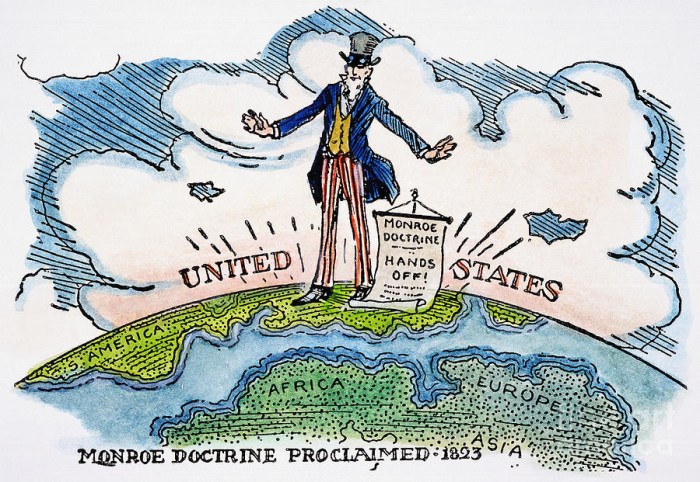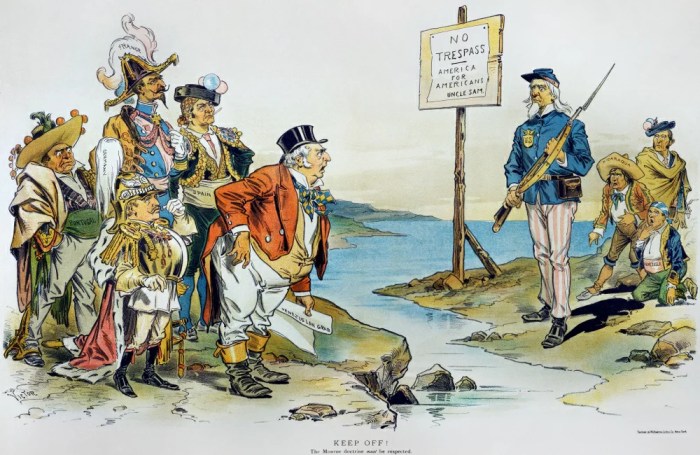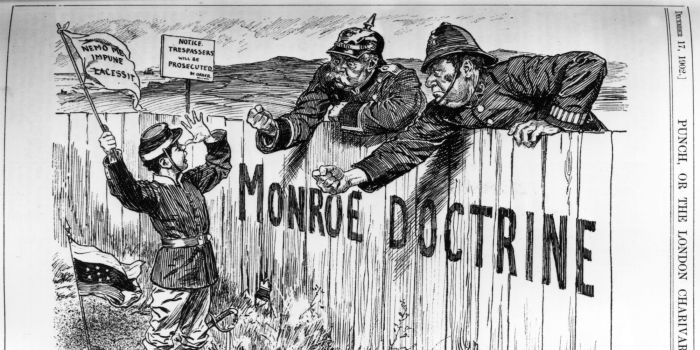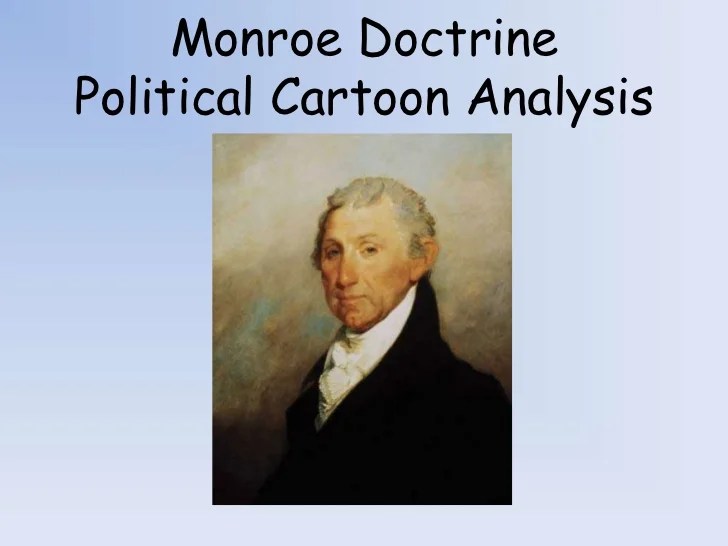Monroe Doctrine Political Cartoon Analysis: Deconstructing American Imperialism delves into the intricate relationship between political cartoons and the Monroe Doctrine, shedding light on the evolution of U.S. foreign policy and its impact on inter-American relations.
Political cartoons have served as powerful tools for expressing public opinion and shaping political discourse, and their examination in the context of the Monroe Doctrine offers valuable insights into the complexities of American imperialism.
Monroe Doctrine Historical Context
The Monroe Doctrine, proclaimed by President James Monroe in 1823, was a significant declaration of U.S. foreign policy in the Americas. Its origins lie in the geopolitical situation of the early 19th century, when European powers were attempting to reassert their influence in the newly independent nations of the Western Hemisphere.
The doctrine’s primary motivation was to prevent European intervention in the Americas and to protect the interests of the United States. It declared that the U.S. would consider any attempt by European powers to colonize or interfere in the affairs of American nations as a threat to its own security.
Geopolitical Situation in the Americas
At the time of the Monroe Doctrine’s creation, the Americas were undergoing significant political and social change. Many former Spanish and Portuguese colonies had recently gained independence, and the U.S. was eager to prevent European powers from re-establishing their control over these territories.
Additionally, the U.S. was concerned about the expansionist ambitions of Russia, which had established a presence in Alaska and was seen as a potential threat to the Pacific Northwest.
Implementation and Evolution
The Monroe Doctrine was initially met with mixed reactions from European powers. Some, such as Great Britain, accepted the doctrine and recognized the U.S. sphere of influence in the Americas.
However, other powers, such as France and Spain, continued to intervene in American affairs, leading to occasional conflicts with the U.S. Over time, the Monroe Doctrine evolved into a broader principle of U.S. dominance in the Western Hemisphere, known as the “Roosevelt Corollary.”
This corollary, formulated by President Theodore Roosevelt in 1904, gave the U.S. the right to intervene in Latin American affairs to protect its interests.
Political Cartoon Analysis

Political cartoons played a significant role in shaping public opinion and political discourse about the Monroe Doctrine. These cartoons often depicted the doctrine as a symbol of U.S. power and influence in the Americas.
Main Themes and Symbols
Common themes and symbols used in political cartoons depicting the Monroe Doctrine include:
- Uncle Sam, representing the United States, as a strong and protective figure.
- European powers, often portrayed as weak or incompetent.
- Latin American nations as either helpless or subservient to the U.S.
- The Monroe Doctrine as a shield or weapon.
Public Opinion and Political Discourse
Political cartoons helped to shape public opinion about the Monroe Doctrine by presenting it as a necessary and just policy. They reinforced the idea that the U.S. had a duty to protect the Americas from European intervention and that the doctrine was essential for maintaining peace and stability in the region.
However, some cartoons also criticized the doctrine, depicting it as a tool for U.S. imperialism and domination in Latin America.
Different Cartoonists’ Interpretations, Monroe doctrine political cartoon analysis
Different cartoonists interpreted the Monroe Doctrine in different ways. Some, such as Thomas Nast, portrayed the doctrine as a positive force, while others, such as Joseph Keppler, criticized it as a form of American arrogance and overreach.
Impact on Inter-American Relations

The Monroe Doctrine had a significant impact on relations between the United States and Latin American countries.
U.S. Foreign Policy
The doctrine shaped U.S. foreign policy in the Americas for over a century. It provided a justification for U.S. intervention in Latin American affairs, including military interventions, economic coercion, and diplomatic pressure.
The doctrine also contributed to the rise of anti-American sentiment in Latin America, as many Latin American nations resented U.S. interference in their affairs.
Latin American Responses
Latin American nations responded to the Monroe Doctrine in various ways. Some nations, such as Mexico and Argentina, initially welcomed the doctrine as a protection against European intervention.
However, over time, many Latin American nations came to view the doctrine as a tool for U.S. domination and began to challenge it. In the 20th century, several Latin American nations adopted policies of non-alignment and neutrality, rejecting the Monroe Doctrine and seeking to reduce U.S.
influence in the region.
Modern Relevance and Interpretations

The Monroe Doctrine remains a topic of debate and controversy in the 21st century.
Continued Relevance
Some scholars argue that the Monroe Doctrine is still relevant today, as it reflects the U.S.’s continued interest in maintaining its dominance in the Americas. The doctrine continues to be cited by U.S. policymakers as a justification for intervention in Latin American affairs.
However, other scholars argue that the doctrine is outdated and no longer reflects the realities of the modern world. They point to the rise of regional organizations, such as the Organization of American States (OAS), which have reduced the need for U.S.
intervention in the region.
Contemporary Debates
Contemporary debates about the Monroe Doctrine focus on its implications for U.S.-Latin American relations. Some argue that the doctrine perpetuates a sense of U.S. superiority and undermines cooperation between the U.S. and Latin American nations.
Others argue that the doctrine is necessary to protect U.S. interests in the region and to prevent other powers from gaining influence in the Americas.
Alternative Perspectives
Alternative perspectives on the Monroe Doctrine include:
- The doctrine as a tool for U.S. imperialism and domination.
- The doctrine as a legitimate defense of U.S. interests.
- The doctrine as an outdated and irrelevant concept.
Artistic Techniques and Styles

Political cartoons depicting the Monroe Doctrine employ various artistic techniques and styles to convey messages and evoke emotions.
Techniques and Styles
Common techniques and styles include:
- Caricature: Exaggerating physical features to create humorous or satirical effects.
- Symbolism: Using symbols to represent abstract ideas or concepts.
- Allegory: Using a story or image to represent a different, often political, meaning.
- Satire: Using humor or irony to criticize or ridicule.
Messages and Emotions
These techniques allow cartoonists to convey complex messages and evoke a range of emotions in their audience. They can use humor to make their point more palatable, or they can use satire to criticize those in power.
Political cartoons about the Monroe Doctrine often evoke feelings of patriotism, pride, or anger, depending on the cartoonist’s perspective on the doctrine.
FAQ Resource: Monroe Doctrine Political Cartoon Analysis
What is the Monroe Doctrine?
The Monroe Doctrine was a policy proclaimed by President James Monroe in 1823, asserting that any further colonization or intervention by European powers in the Americas would be considered an act of aggression against the United States.
How did political cartoons contribute to the public discourse surrounding the Monroe Doctrine?
Political cartoons played a significant role in shaping public opinion about the Monroe Doctrine. They often depicted the doctrine as a means of protecting American interests and preventing European influence in the Western Hemisphere.
What are some of the main themes explored in political cartoons about the Monroe Doctrine?
Common themes in political cartoons about the Monroe Doctrine include American exceptionalism, the role of the United States as a protector of the Americas, and the potential for conflict with European powers.